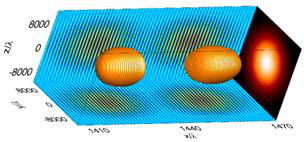武慧春教授邀请到上海交通大学激光等离子体物理研究所的陈民教授, 翁苏明研究员和远晓辉副研究员, 定于2017年11月6-7号进行学术交流. 陈民教授将关注毛细管放电在激光等离子体实验中的应用及其相关的放电数值模拟. 翁苏明研究员将报告其最近在强场物理中的极端法拉第旋转效应工作. 远晓辉副研究员将针对与浙大合作启动的高空气球实验进行交流.
翁苏明研究员的报告
日期:11月7号
时间:14:00
地点:教十一413
摘要:
Extreme case of Faraday effect in strongly magnetized plasmas
Suming Weng
The Faraday effect or Faraday rotation observed in 1846 was the first experimental evidence of the electromagnetic wave nature of light. In general, this effect causes a polarization rotation of light during its propagation along the magnetic field in a medium. In principle, this is caused by magneto-chiral dichroism of left-circularly polarized and right-circularly polarized electromagnetic waves propagating at differential phase speeds in magnetized materials. To date, the Faraday effect plays a pivot role in many applications such as the manipulation of light, and the probing of magnetic fields and material’s properties.
In the talk, we will report an extreme case of the Faraday effect that a linearly polarized ultrashort laser pulse splits in time into two circularly polarized pulses of opposite handedness during its propagation in a highly magnetized plasma[1]. This offers a new degree of freedom to manipulate ultrashort and ultrahigh power laser pulses. Together with technologies of ultra-strong magnetic fields, it may pave the way for novel optical devices, such as magnetized plasma polarizers. The latter could allow the generation of circularly polarized laser pulses as high power as 10 PW in up-to-date laser facilities. The resultant high-power circularly polarized pulses are particularly attractive for laser-driven ion acceleration, and optical control of mesoscopic objects. In addition, it may offer a powerful means to measure strong magnetic fields broadly existing in objects in the universe and in laser–matter interactions in laboratories.

Figure: Sketch and simulation result of the magnetic splitting of an ultrashort linearly polarized (LP) laser pulse, which is incident along the magnetic field B into a plasma. The right-circularly polarized (RCP) sub-pulse follows the left-circularly polarized (LCP) sub-pulse in time.
[1] S. M. Weng, Q. Zhao, Z. M. Sheng et al.. Extreme case of Faraday effect: Magnetic splitting of ultrashort laser pulses in plasmas. Optica 4(9), 1086-1091 (2017).


